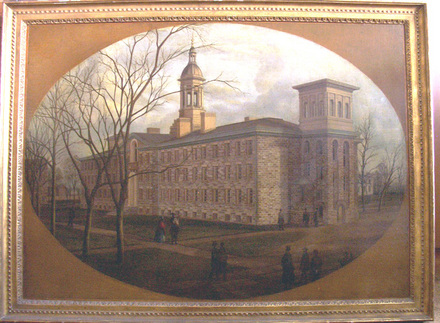Attributed to Frank Childs, [View of Nassau Hall, Princeton, New Jersey], ca. 1859. Oil on canvas. Graphic Arts American Paintings
“On the night of Saturday, March 10, 1855, Nassau Hall was destroyed by fire,” writes Robert C. Smith. “At precisely half past eight, as the Philadelphian Society was ending its meeting on the fourth floor of the building, the cry of fire was heard from below. ‘Every effort,’ President Maclean later told the Trustees, ‘was made to subdue the flames but without success.’ As soon as it was realized that the firemen, without sufficient water to prime their noses, were powerless to stop the flames, whipped to the roof by a strong wind, the work of salvaging began.”
“‘The students and professors worked finely at the fire,’ one student wrote, ‘and all distinction seemed to be lost in the general confusion.’ Henry C. Cameron, Tutor in Greek, and a student named Gilchrist ‘burst open’ the door of the picture gallery and began handing the portraits to safety. George Musgrave Giger, Professor of Latin, and his colleagues Professors Duffield and Alexander forced their way through the blaze to rescue papers and other valuable property. The old bust of Homer was hauled down from over the center door, while ‘General’ Perrine, a Princeton character of the time, rode up to direct the evacuation.”
“By midnight all was over and everything of moment to the College had been saved, except the bell, which had survived the earlier fire of 1802. Some students had lost all they possessed, but no one was hurt save James Bayles of Kingston, who fell and broke his leg.” From Robert C. Smith, “John Notman’s Nassau Hall,” in Princeton University Library Chronicle XIV, no. 3 (spring 1953). http://libweb5.princeton.edu/visualmaterials/pulc/pulcv14n_3.pdf
This painting depicts Nassau Hall (built in 1756) after it was restored and revised by the architect John Notman (1810-1865). Notman made a number of exterior changes to the building, including the staircases at the ends of the building and the arched front doorway.
